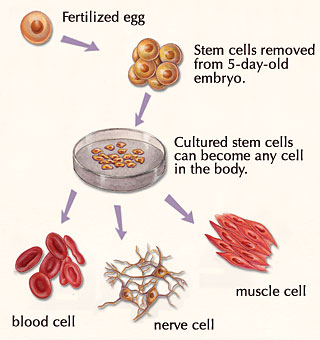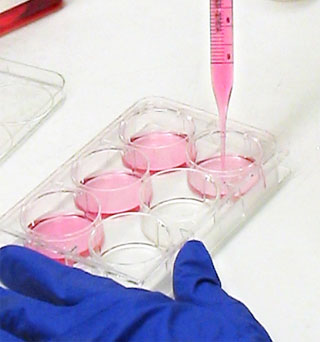Stem Cells: Cells with Potential
Why invest so much in studying stem cells?
Stem cells have captured the public's attention because of their potential to revolutionize ourtreatment of many debilitating diseases and injuries. Using stem cells, we may someday be able to repair spinal cord injuries or replace diseased organs, although such therapeutic treatments are probably a long way off. The study of stem cells is relatively new—they were discovered in 1976, and human embryonic stem cells finally isolated in 1998—so scientists still have much to learn about them.
Right now, researchers are still learning how to generate and grow stem cells. But simply knowing how to culture the cells in the lab isn’t enough. Scientists also need to understand and control how stem cells differentiate to become specific cell types. If researchers can decode the signals that govern differentiation, they may be able to take charge of the process, directing a culture of cells to become a specific cell type—heart, neuron, skin, liver, or whatever kind is needed.
Stem cells have captured the public's attention because of their potential to revolutionize ourtreatment of many debilitating diseases and injuries. Using stem cells, we may someday be able to repair spinal cord injuries or replace diseased organs, although such therapeutic treatments are probably a long way off. The study of stem cells is relatively new—they were discovered in 1976, and human embryonic stem cells finally isolated in 1998—so scientists still have much to learn about them.
Right now, researchers are still learning how to generate and grow stem cells. But simply knowing how to culture the cells in the lab isn’t enough. Scientists also need to understand and control how stem cells differentiate to become specific cell types. If researchers can decode the signals that govern differentiation, they may be able to take charge of the process, directing a culture of cells to become a specific cell type—heart, neuron, skin, liver, or whatever kind is needed.





Cultivation of stem cells from days-old embryos
With that level of control, researchers could pursue a variety of new treatments. They may be able to grow new tissues to replace damaged ones. For example, many scientists are looking ways of generating heart cells in the hope of replacing cardiac tissue destroyed by a heart attack. but stem cells may have an even bigger impact by giving researchers new ways to study disease. Because embryonic stem cells have the potential to be turned into almost any kind of cell, researchers can culture cells that mimic a variety of diseases. These cultures would provide an almost unlimited supply of cells that could be used to test thousands of drugs. Such rapid screening could make useful drugs available years earlier than they might be otherwise. In addition, simply watching and deciphering the development of stem cells into tissues will give researchers insight into how cells communicate with each other and form the networks used in functions like learning and memory.
Progress....and hurdles
Treatments for a few particular diseases have emerged as exciting possibilities on the forefront of stem cell research. Parkinson’s results from the death of a specific type cell in the brain. Scientists have succeeded in easing the condition in rats by injecting them with embryonic stem cells that then turned into the missing neurons. Researchers hope to develop a similar treatment for diabetes, which is caused by the destruction of insulin-producing cells in the pancreas.
Though there has been progress in developing new stem cell-based therapies, researchers caution that many hurdles remain. For example, it’s unclear whether implanted stem cells can, after differentiating, revert to their previous state and then cause cancer. Another problem involves our natural immune response to foreign cells in the body. Patients currently receiving stem cell treatments, such as bone marrow transplants, must take drugs to prevent their immune system from attacking the newly introduced cells. Scientists may be able to address this problem by creating banks of embryonic stem cells, each of which is slightly different genetically. The cells best suited to a patient’s genetic makeup would then be used to grow new cells for transplantation, in hopes that this would lessen the immune response.
Progress....and hurdles
Treatments for a few particular diseases have emerged as exciting possibilities on the forefront of stem cell research. Parkinson’s results from the death of a specific type cell in the brain. Scientists have succeeded in easing the condition in rats by injecting them with embryonic stem cells that then turned into the missing neurons. Researchers hope to develop a similar treatment for diabetes, which is caused by the destruction of insulin-producing cells in the pancreas.
Though there has been progress in developing new stem cell-based therapies, researchers caution that many hurdles remain. For example, it’s unclear whether implanted stem cells can, after differentiating, revert to their previous state and then cause cancer. Another problem involves our natural immune response to foreign cells in the body. Patients currently receiving stem cell treatments, such as bone marrow transplants, must take drugs to prevent their immune system from attacking the newly introduced cells. Scientists may be able to address this problem by creating banks of embryonic stem cells, each of which is slightly different genetically. The cells best suited to a patient’s genetic makeup would then be used to grow new cells for transplantation, in hopes that this would lessen the immune response.





Embryonic stem cells can be grown in culture dishes. A pinkish solution provides the sugars and other compounds the cells need to grow.
Ideally, researchers would like to emulate the regenerative qualities of animals like the salamander. When a salamander loses a limb, cells near the injury “regress” and become stem cells. They then re-differentiate and organize themselves into tissues. If such a process could be induced in human cells, scientists could grow replacement tissue from a patient’s own cells, avoiding the immune reactions that arise when foreign tissue is used in a transplant. In addition, because the patients thhemselves would be providing the initial cells, scientists wouldn’t have to culture embryonic stem cells. But this kind of regeneration is a futuristic scenario; there hasn’t yet been enough research to know whether the treatments promised by these ideas are even possible.
Next: Looking forward »
Next: Looking forward »


